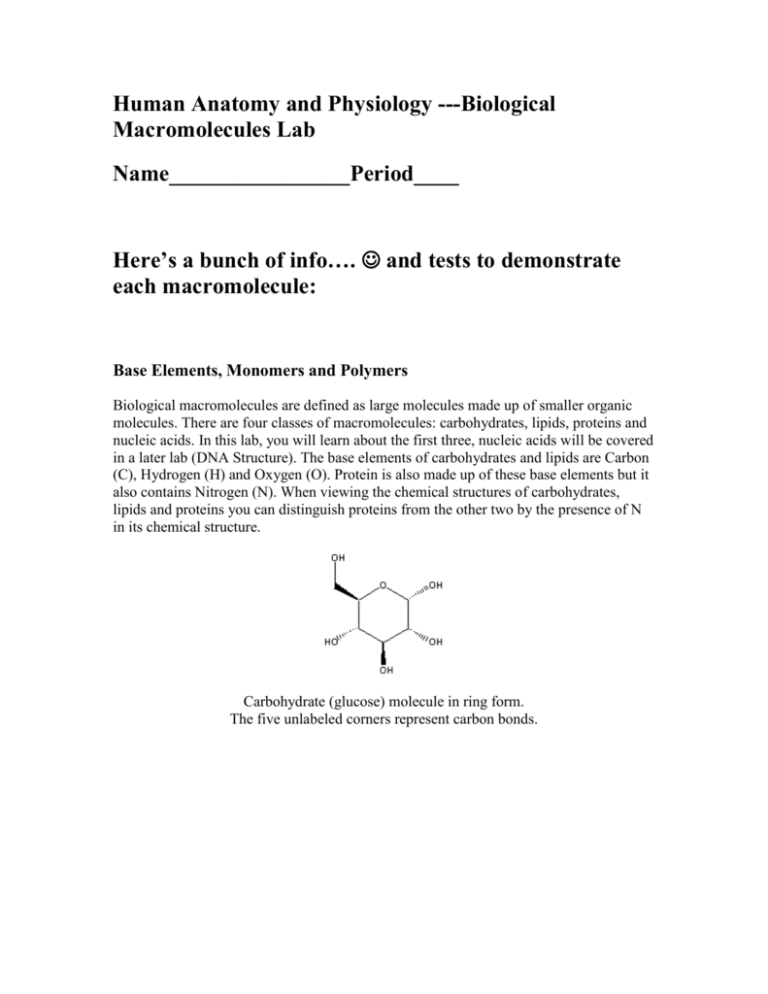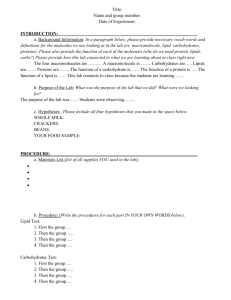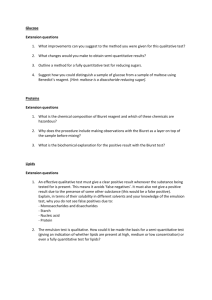hapmacromoleculeLab
advertisement

Human Anatomy and Physiology ---Biological Macromolecules Lab Name________________Period____ Here’s a bunch of info…. and tests to demonstrate each macromolecule: Base Elements, Monomers and Polymers Biological macromolecules are defined as large molecules made up of smaller organic molecules. There are four classes of macromolecules: carbohydrates, lipids, proteins and nucleic acids. In this lab, you will learn about the first three, nucleic acids will be covered in a later lab (DNA Structure). The base elements of carbohydrates and lipids are Carbon (C), Hydrogen (H) and Oxygen (O). Protein is also made up of these base elements but it also contains Nitrogen (N). When viewing the chemical structures of carbohydrates, lipids and proteins you can distinguish proteins from the other two by the presence of N in its chemical structure. Carbohydrate (glucose) molecule in ring form. The five unlabeled corners represent carbon bonds. A lipid (triglyceride) molecule. A protein molecule. X denotes a functional group. Note the presence of N. Each macromolecule is made up of smaller organic molecules. For carbohydrates and proteins these smaller molecules are known as monomers. These similar or identical monomers are covalently bonded together to create a large polymer molecule. The monomer unit for carbohydrates is a monosaccharide or a simple sugar. When two of these monosaccharides are linked by covalent bonds a disaccharide is created. When several monosaccharides are bonded together a polysaccharide, or complex sugar, is created. Polysaccharides are the polymers of carbohydrates. Proteins are made up of monomers called amino acids. There are twenty amino acids and they can be strung together in unique combinations known as polypeptide chains, the polymer unit for proteins. A protein is only complete and functional when the polypeptide chain is folded into a unique 3-D shape, a concept discussed in your textbook. The exception to the monomer/polymer rule is lipids. Lipid base units are not considered monomers. One type of lipid or fat is made up of fatty acids and glycerol molecules in a 3:1 ratio. The bonding of three fatty acids to one glycerol molecule creates a triglyceride. Monomers, or base units are bonded together to create larger molecules via dehydration. This involves the removal of a water molecule at the bonding site. The larger molecule can be broken down by the reverse process, hydrolysis. This occurs when water is added to break the covalent bonds created during dehydration. Carbohydrates The body uses carbohydrates as “fast fuel.” It is the first macromolecule used to obtain energy for the body because very little energy is required to break down carbohydrates. You will learn how it is used to create energy in the Photosynthesis and Respiration lab. Carbohydrates are sugar molecules. They are made up of the base elements C, H and O in a 1:2:1 ratio. The simplest carbohydrate is a monosaccharide (a simple sugar). An example of a simple sugar is glucose, which is created during photosynthesis. Monosaccharides are covalently bonded together to create more complex sugars. A disaccharide is two covalently bonded simple sugars or monosaccharides. A polysaccharide is the carbohydrate polymer and consists of several monosaccharides bonded together. A common polysaccharide, the one you will look at in lab, is starch. Starch is a storage polysaccharide found in plants. Another plant polysaccharide is cellulose, a major component of a plant’s cell wall. In lab you will test for the presence of glucose, a monosaccharide carbohydrate, and for starch, a polysaccharide carbohydrate, in a series of liquid substances. To test for the presence of glucose you will use the Benedict’s Test for Reducing Sugars (monosaccharides). Benedict’s reagent is clear blue (from the presence of cupric copper ions, Cu++ ) but when combined and heated to boiling with a substance containing glucose in a chain form, the cupric ions are reduced to a cuprous form (Cu+ ) and then oxidized to form copper oxide (Cu2O). Copper oxide is a brownish-orange substance that is insoluble in water. Therefore, a positive reaction in a Benedict’s Test is the change of the clear light blue solution to an opaque orange-brown solution in a boiling water bath. This color change indicates the presence of Glucose in a given solution. Can you identify the positive Benedict’s Test versus the negative test? To test for the presence of starch, the Starch Test is used. This is a simple test in which iodine is added to a given solution. If a polysaccharide such as starch is present then the iodine ion will lodge itself in the polysaccharide chain and give it a black-blue color. If iodine added to a solution turns black-blue than starch is present. If the solution remains the color of iodine, reddish-orange, there is no starch present, a negative test. Is this a positive or negative Starch Test? Excellent Carbohydrate Review Excellent Carbohydrate Kids Site Lipids The body stores lipids as reserve energy. Lipids are hydrophobic (“water-hating”) and thus much harder to break down for energy than carbohydrates. Lipids, however, contain more energy per unit weight then carbohydrates. Therefore it is more efficient for the body to use lipids as stored energy. The body will use its carbohydrate source for initial fuel, but if the “fast fuel” runs out, the body will turn to breaking down lipids for a rich energy source. Lipids are fat molecules and there are many different kinds. In this lab, we will study triglyceride molecules, those used by organisms for energy storage. Triglycerides are composed of three fatty acid molecules and one glycerol molecule bonded in an ester linkage. The base elements of these molecules are C, H and O. Like lipids, the chemical Sudan IV is not soluble in water; it is, however, soluble in lipids. Therefore to test for the presence of lipids in a solution you will use a Sudan IV Test. In this test dark red Sudan IV is added to a solution along with ethanol to dissolve any possible lipids. If lipids are present the Sudan IV will stain them reddish-orange, giving a positive test. A positive Sudan IV test in a solution containing nuts. Excellent Lipids Kids Site Another Excellent Lipids Site One more Lipids Site Proteins The last macromolecule you will explore in this lab is protein. Proteins are the most complex and functionally diverse molecules of living organisms. Proteins compose enzymes, blood cells and muscle tissue just to name a few and are therefore associated with meat products. Proteins are created by RNA during DNA Transcription and Translation, a process you will learn about in a later lab. The base elements of proteins are C, H, O and N. The monomers of proteins are 20 different amino acids. The amino acids are bonded together in unique combinations to create a polypeptide chain, the protein polymer. This chain is then folded into a unique, functional protein. In this lab you will test for the presence of protein using the Biuret Test. Like the Benedict’s Reagent, Biuret Reagent contains copper ions. These copper ions reflect off closely clustered amide groups of proteins casting a violet color to a solution with proteins. This violet color is a positive reaction in a Biuret Test. All three tubes underwent a Biuret Test. Which is the positive control? Which is the negative control? Image of a complex protein. Excellent Protein Review Excellent Protein Kids Site Review Questions - Monosaccharides and polysaccharides are two classes of ______________. - Long chains of amino acids make up ___________ and contain the atom _____________ which is unique to this macromolecule. - Fats like triacylglycerols are the macromolecule _______________. - We looked at two typed of carbohydrates in lab. Glucose is a simple sugar called a _____________, whereas starch contains compound carbon chains and is a _____________. - What is the difference between an aldose and a ketose? - Polysaccharides are formed by a dehydration synthesis reaction between monosaccharides. What does this mean? - For each of the following tests, please circle which substance would give a positive result: 1. Benedict's test - glucose tap water oil (lipid)) starch protein 2. Starch test - glucose tap water oil (lipid)) starch protein 3. Sudan IV test - glucose tap water oil (lipid)) starch protein 4. Biuret test - glucose tap water oil (lipid)) starch protein - All proteins contain carbon, hydrogen, oxygen and what other element? - When one glycerol molecule covalently bonds via dehydration synthesis with three fatty acid molecules the resulting macromolecule is called a _____________. - What are the two general categories of carbohydrates? - Protein molecules contain carbon, oxygen, hydrogen and _______________. - ID the test: Sudan IV, Benedict's, Biuret, Starch 1. The cloudy, orange color that shows a positive result for the ___________ test is due to simple sugars reducing cupric ions to cuprous ions which oxidize to form copper oxide. 2. If a solution contains macromolecules that test positive for the ___________ test, light refracts from copper-containing rings to produce a violet color. 3. The reagent used in the ____________ test is soluble in lipid, but not in water. Adding ethanol to test solutions is necessary. - Explain the difference between lipids and carbohydrates with respect to energy use and storage. - What caused the food dye to diffuse faster in hot water than in cold water?








